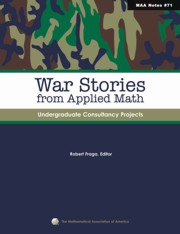Book contents
- Frontmatter
- Contents
- Introduction
- An Industrial Mathematics Program
- Source of Problems: Industrial Contacts
- Panel Discussion Following “Industrial Contacts”
- Course Integration
- The Consortium for Mathematics and Its Applications (COMAP)
- Program Management
- Project Deliverables I
- Project Deliverables II
- Using Projects from Industry to Teach Mathematics and Statistics to Liberal Arts Majors
- Mathematical Modeling in ICIC Projects
- Appendix: A Sample HMC Report
Source of Problems: Industrial Contacts
- Frontmatter
- Contents
- Introduction
- An Industrial Mathematics Program
- Source of Problems: Industrial Contacts
- Panel Discussion Following “Industrial Contacts”
- Course Integration
- The Consortium for Mathematics and Its Applications (COMAP)
- Program Management
- Project Deliverables I
- Project Deliverables II
- Using Projects from Industry to Teach Mathematics and Statistics to Liberal Arts Majors
- Mathematical Modeling in ICIC Projects
- Appendix: A Sample HMC Report
Summary
Harvey Mudd College (HMC) students may be involved in an industrial mathematics project through the college's Mathematics Clinic which runs for a full academic year. We call our program the Mathematics Clinic, a name which exposes us to some criticism. In mathematics, a “clinic” is a place for remedial work, right? You go to the clinic if you can't do the problem. At HMC, the word “clinic” is more closely related to what hospitals do. If you are sick, you might go to a major university hospital that has a board of experts, and this board of experts will analyze your problem and solve it for you. That's where the clinic idea came from. We didn't invent it; we took it over from the engineers who named what they set up in 1964 the “Engineering Clinic.”
We mathematicians were invited to become involved in their program, but we never really were partners. We could be consultants and spend time on projects, but we never got release time to do anything, nor did we get any credit for what we did. When we made a proposal to open up their clinic program to the entire college, we were turned down. They wanted to retain the clinic designation and keep it for themselves and so we decided at that time, in 1973, to start our own program which we called the Mathematics Clinic.
To everyone's surprise, it was successful. We started small, with one project at the very beginning. It was very successful, and we built on that. We had support from the Sloan Foundation and the National Science Foundation.
- Type
- Chapter
- Information
- War Stories from Applied MathUndergraduate Consultancy Projects, pp. 25 - 38Publisher: Mathematical Association of AmericaPrint publication year: 2007

